Treatment and Analysis of Multiparametric Time Series from a Seismogeodetic System for Tectonic Monitoring of the Gulf of Cadiz, Spain †
Abstract
1. Introduction
2. Methodology
Seismogeodetic System Description (Hardware, Software and Processing Techniques)

3. Results
Case Study: 4.4 Mw Earthquake That Occurred on 1 January 2022, in the Gulf of Cadiz
4. Conclusions
Author Contributions
Funding
Institutional Review Board Statement
Informed Consent Statement
Data Availability Statement
Acknowledgments
Conflicts of Interest
Abbreviations
| AIUB | Astronomical Institute of the University of Bern |
| CATS | Create and Analyze Time Series |
| cGPS | Continuous Global Positioning System |
| CSIC | Consejo Superior de Investigaciones Científicas |
| EBD | Estación Biológica Doñana |
| EWS | Early Warning System |
| GPS | Global Positioning System |
| GNSS | Global Navigation Satellite System |
| IGN | Instituto Geográfico Nacional |
| IGS | International GNSS Services |
| ITRF | Internacional Terrestrial Reference Frame |
| JPL | Jet Propulsion Laboratory |
| LAGC | Laboratorio de Astronomía Geodesia y Cartogrfía |
| MEMS | Micro Electro Mechanical Systems |
| NAS | Network Attached Storage |
| NTP | Network Time Protocol |
| PPP | Precise Point Positioning |
| RSync | Remote Syncronization |
| UCA | Universidad de Cádiz |
| UTC | Universal Time Coordinated |
| VPN | Virtual Network Protocol |
References
- Baptista, M.A.; Miranda, J.M.; Chierici, F.; Zitellini, N. New study of the 1755 earthquake source based on multi–channel seismic survey data and tsunami modeling. Nat. Hazards Earth Syst. Sci. 2003, 3, 333–340. [Google Scholar] [CrossRef]
- Baptista, M.A.; Miranda, J.M. Revision of the Portuguese catalog of tsunamis. Nat. Hazards Earth Syst. Sci. 2009, 9, 25–42. [Google Scholar] [CrossRef]
- Leica Geosystems Official Website. Leica GR30 GNSS Receiver Datasheet. Available online: https://leica-geosystems.com/en-gb/products/gnss-reference-networks/receivers/leica-gr50-and-gr30 (accessed on 11 September 2020).
- RST Instruments Official Website. Digital Tilt Loggers Specifications. Available online: https://rstinstruments.com/product/dtl201b-dtl202b-uniaxial-biaxial-digital-tilt-loggers/ (accessed on 10 November 2021).
- Raspberry Official Website. Raspberry Shake RS4D Specifications Manual. Available online: https://manual.raspberryshake.org/_downloads/SpecificationsforRaspberryShake4DMEMSV4.pdf (accessed on 11 November 2021).
- Vaisala Instruments Official Website. Vaisala “WKT520” User Guide. Available online: https://www.vaisala.com/sites/default/files/documents/M210906EN-C.pdf (accessed on 21 September 2020).
- Cisco System Official Website. What Is a VPN? Available online: https://www.cisco.com/c/en/us/products/security/vpn-endpoint-security-clients/what-is-vpn.html (accessed on 21 September 2021).
- SSH Home Page. SFTP File Transfer Protocol-Get SFTP Client & Server. Available online: https://www.ssh.com/academy/ssh/sftp (accessed on 10 September 2021).
- Rsync Official Website. Rsync Home Page. Available online: https://rsync.samba.org/ (accessed on 11 September 2021).
- NTP Official Website. Network Time Foundation’s NTP Support Wiki. Available online: https://support.ntp.org/bin/view/Main/WebHome (accessed on 1 October 2021).
- Ublox Official Website. UBlox USB GNSS Receiver Manual. Available online: http://bit.ly/QGPgnss (accessed on 14 February 2021).
- Synology Official Website. Synology Hardware Specifications. Available online: https://www.synology.com/es-es/products/RS1221+ (accessed on 10 September 2019).
- USGS Official Website. SWARM Home Page. Available online: https://volcanoes.usgs.gov/software/swarm/index.shtml (accessed on 10 January 2021).
- SEISAN Official Website. SEISAN Home Page. Available online: http://www.seisan.info/ (accessed on 19 January 2021).
- Bernese GNSS Software Official Website. Bernese Software Home Page. Available online: http://www.bernese.unibe.ch/ (accessed on 5 January 2021).
- Dach, R.; Lutz, S.; Walser, P.; Fridez, P. Bernese GNSS Software Version 5.2. User Manual; Astronomical Institute, University of Bern, Bern Open Publishing: Bern, Switzerland, 2015; ISBN 978-3-906813-05-9. Available online: https://boris.unibe.ch/id/eprint/72297 (accessed on 10 January 2021).
- UNAVCO Official Website. Gipsy–Oasis Description. Available online: https://www.unavco.org/software/data-processing/postprocessing/gipsy/gipsy.html (accessed on 15 January 2021).
- Barba, P.; Rosado, B.; Ramírez–Zelaya, J.; Berrocoso, M. Comparative Analysis of Statistical and Analytical Techniques for the Study of GNSS Geodetic Time Series. Eng. Proc. 2004, 5, 21. [Google Scholar] [CrossRef]
- Citrix Xen Server Official Website. XenServer 7.0 Standard Edition Web Page. Available online: https://www.citrix.com/es-es/downloads/citrix-hypervisor/product-software/xenserver-70-standard-edition.html (accessed on 15 February 2019).
- Stich, D.; Mancilla, F.; Morales, J. Crust–mantle coupling in the Gulf of Cadiz (SW–Iberia). Geophys. Res. Lett. 2005, 32, L13306. [Google Scholar] [CrossRef]
- Stich, D.; Martin, R.; Morales, J. Moment tensor inversion for Iberia–Maghreb earthquakes (2005–2008). Tectonophysics 2010, 483, 390–398. [Google Scholar] [CrossRef]
- Martín, R.; Stich, D.; Morales, J.; Mancilla, F. Moment tensor solutions for the Iberian–Maghreb region during the IberArray deployment (2009–2013). Tectonophysics 2015, 663, 261–274. [Google Scholar] [CrossRef]
- Larson, K.M.; Bodin, P.; Gomberg, J. Using 1–Hz GPS Data to Measure Deformations Caused by the Denali Fault Earthquake. Science 2003, 300, 1421–1424. [Google Scholar] [CrossRef]
- Shu, Y.; Fang, R.; Geng, J.; Zhao, Q.; Liu, J. Broadband velocities and displacements from integrated GPS and accelerometer data for high--rate seismogeodesy. Geophys. Res. Lett. 2018, 45, 8939–8948. [Google Scholar] [CrossRef]
- Bilich, A.; Cassidy, J.F.; Larson, K.M. GPS Seismology: Application to the 2002 Mw 7.9 Denali Fault Earthquake. Bull. Seismol. Soc. Am. 2008, 98, 593–606. [Google Scholar] [CrossRef]

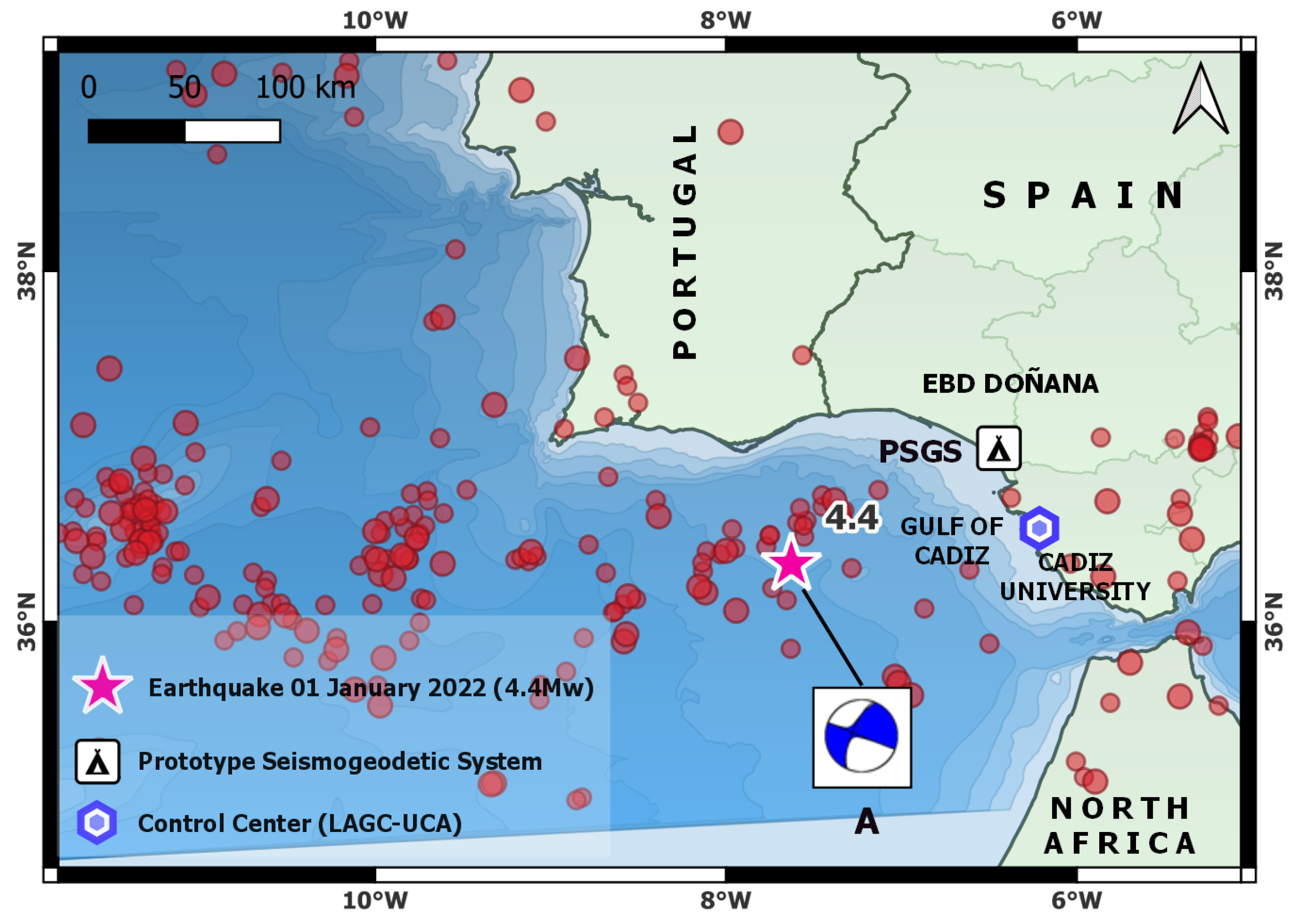
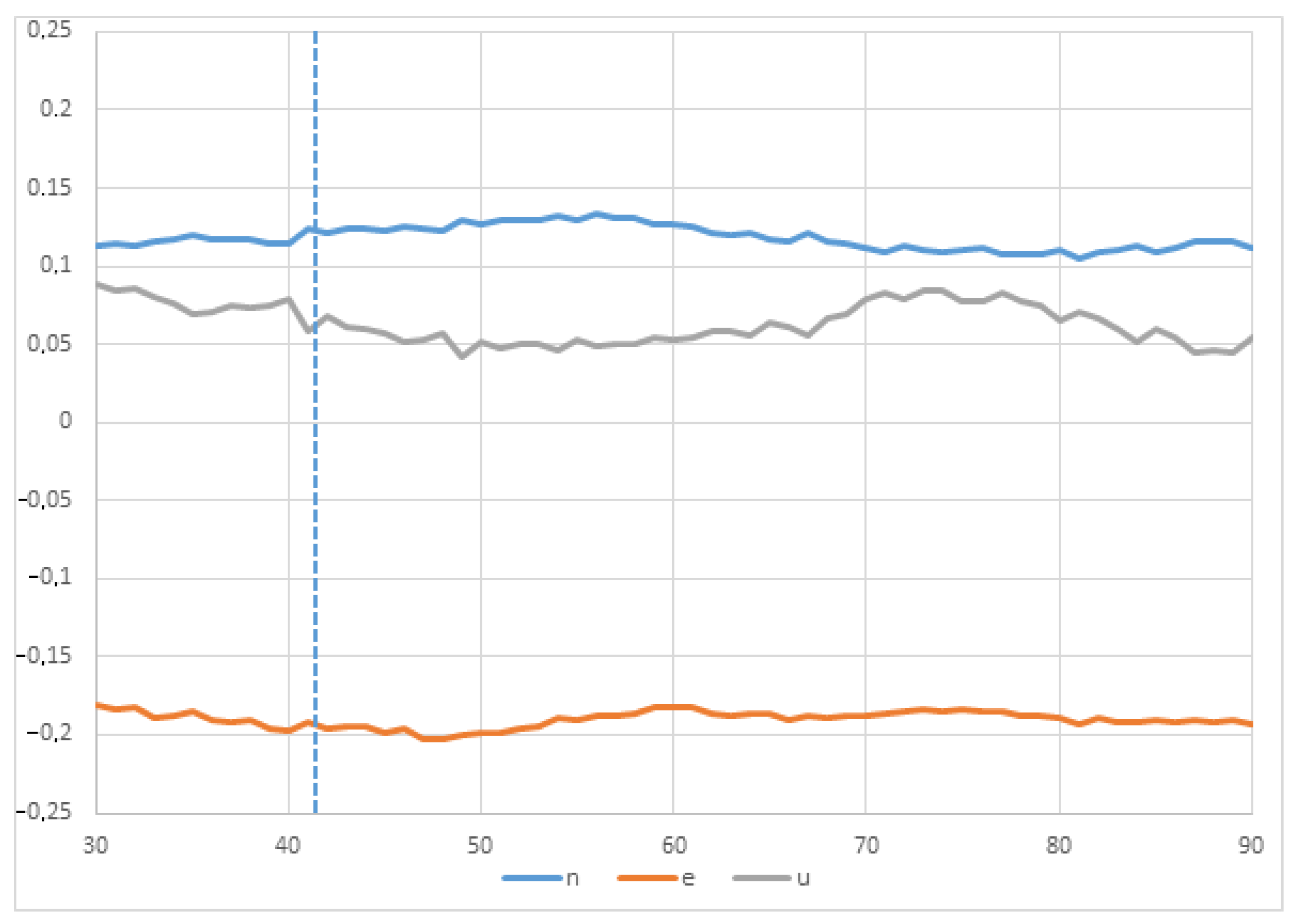
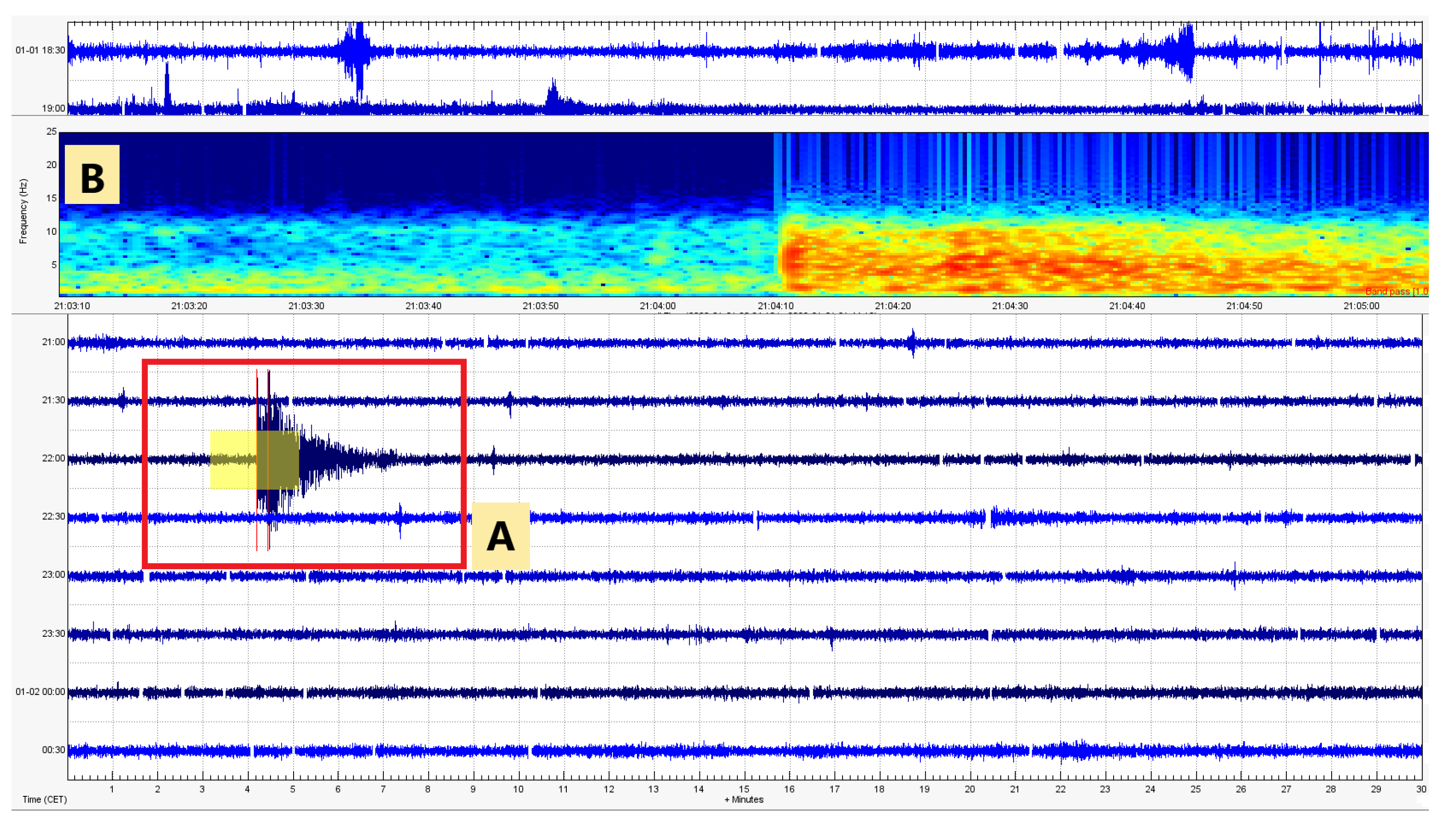
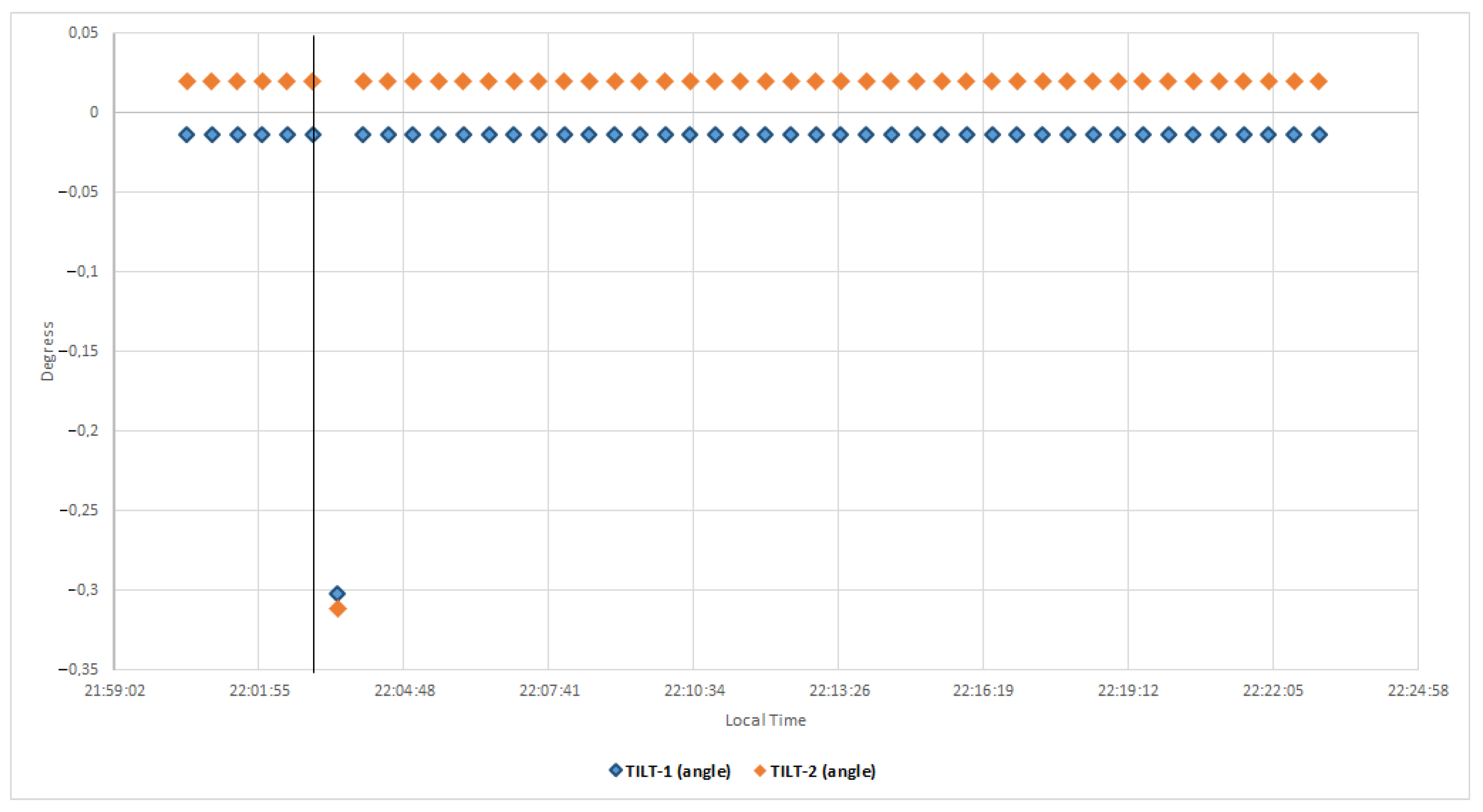
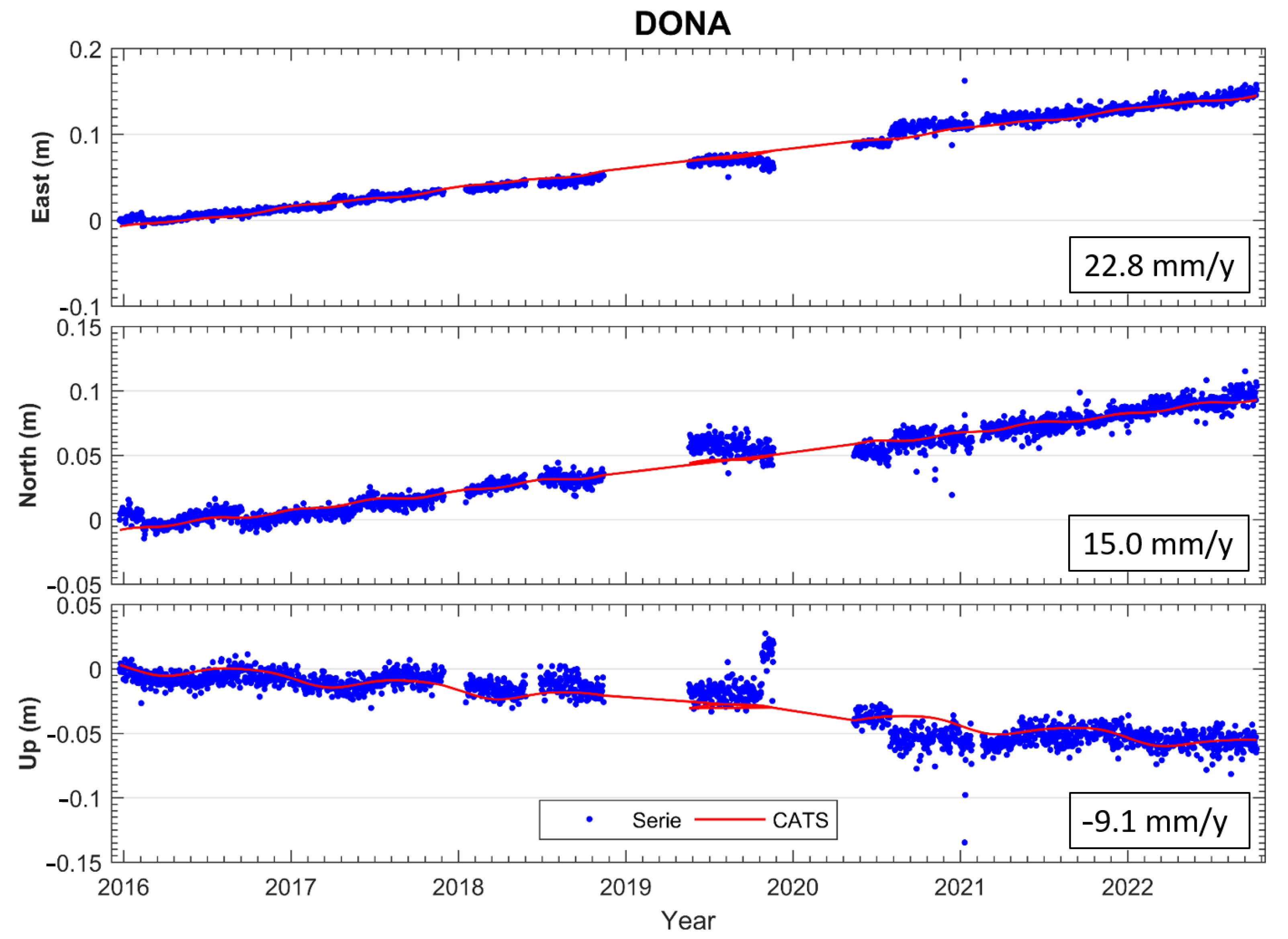
Disclaimer/Publisher’s Note: The statements, opinions and data contained in all publications are solely those of the individual author(s) and contributor(s) and not of MDPI and/or the editor(s). MDPI and/or the editor(s) disclaim responsibility for any injury to people or property resulting from any ideas, methods, instructions or products referred to in the content. |
© 2023 by the authors. Licensee MDPI, Basel, Switzerland. This article is an open access article distributed under the terms and conditions of the Creative Commons Attribution (CC BY) license (https://creativecommons.org/licenses/by/4.0/).
Share and Cite
Ramírez-Zelaya, J.; Jiménez, V.; Barba, P.; Rosado, B.; Gárate, J.; Berrocoso, M. Treatment and Analysis of Multiparametric Time Series from a Seismogeodetic System for Tectonic Monitoring of the Gulf of Cadiz, Spain. Eng. Proc. 2023, 39, 9046. https://doi.org/10.3390/engproc2023039046
Ramírez-Zelaya J, Jiménez V, Barba P, Rosado B, Gárate J, Berrocoso M. Treatment and Analysis of Multiparametric Time Series from a Seismogeodetic System for Tectonic Monitoring of the Gulf of Cadiz, Spain. Engineering Proceedings. 2023; 39(1):9046. https://doi.org/10.3390/engproc2023039046
Chicago/Turabian StyleRamírez-Zelaya, Javier, Vanessa Jiménez, Paola Barba, Belén Rosado, Jorge Gárate, and Manuel Berrocoso. 2023. "Treatment and Analysis of Multiparametric Time Series from a Seismogeodetic System for Tectonic Monitoring of the Gulf of Cadiz, Spain" Engineering Proceedings 39, no. 1: 9046. https://doi.org/10.3390/engproc2023039046
APA StyleRamírez-Zelaya, J., Jiménez, V., Barba, P., Rosado, B., Gárate, J., & Berrocoso, M. (2023). Treatment and Analysis of Multiparametric Time Series from a Seismogeodetic System for Tectonic Monitoring of the Gulf of Cadiz, Spain. Engineering Proceedings, 39(1), 9046. https://doi.org/10.3390/engproc2023039046






